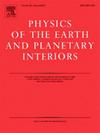Attenuation and scattering in the innermost inner core
IF 1.9
3区 地球科学
Q2 GEOCHEMISTRY & GEOPHYSICS
引用次数: 0
Abstract
Attenuation of PKIKP waves transmitted through the inner core of Earth is modeled to constrain the depth of a transition between an outer and inner inner core having a change in elastic anisotropy. Using reference waveforms inverted from earthquake source-time functions and an average mantle attenuation operator, fits to observed PKIKP waveforms are determined for a two layered model of P wave attenuation in the inner core in which 1/QP at 1 Hz has a sharp decrease in a 100 km thick transition zone centered at 650 km radius from Earth's center, coincident with the radius estimated for a change in elastic anisotropy. The attenuation of broadband PKIKP waveforms is found to be dominated by viscoelastic rather than by scattering attenuation. Bounds for parameters describing the spatial spectrum of heterogeneity of the inner inner core, consistent with the scattered coda of both forward scattered PKIKP and back-scattered PKiKP, are estimated to between 4 and 6 km at 2 % and 1 to 2 km at 1 %, for the corner scale length and P velocity fluctuation assuming an exponential autocorrelation. Strong antipodal focusing of scattered waves is observed and predicted from this heterogeneity, particularly within 0.5 great circle degrees of the antipode. Hypotheses for the transition in anelasticity and anisotropy of the - inner inner core include changes in the inner core's composition, superionic state, and/or a change in its heterogeneity texture or crystalline lattice structure.

最内层核心的衰减和散射
通过地球内核传输的PKIKP波的衰减被模拟为约束具有弹性各向异性变化的外层和内层内核之间过渡的深度。利用震源-时间函数反演的参考波形和平均地幔衰减算子,确定了对两层模型的观测到的PKIKP波形的拟合,其中1/QP在1 Hz时在距地球中心650 km半径处100 km厚的过渡区急剧下降,与弹性各向异性变化的估计半径一致。发现宽带PKIKP波形的衰减主要是粘弹性衰减而不是散射衰减。对于角尺度长度和P速度波动假设为指数自相关,描述内核空间非均质谱的参数边界与前向散射PKIKP和后向散射PKIKP的散射谱一致,在2%时估计为4 ~ 6 km,在1%时估计为1 ~ 2 km。根据这种非均质性,观察和预测了散射波的强对映面聚焦,特别是在对映面0.5大圆度范围内。关于内核非弹性和各向异性转变的假设包括内核组成、超离子态和/或其非均质织构或晶格结构的变化。
本文章由计算机程序翻译,如有差异,请以英文原文为准。
求助全文
约1分钟内获得全文
求助全文
来源期刊

Physics of the Earth and Planetary Interiors
地学天文-地球化学与地球物理
CiteScore
5.00
自引率
4.30%
发文量
78
审稿时长
18.5 weeks
期刊介绍:
Launched in 1968 to fill the need for an international journal in the field of planetary physics, geodesy and geophysics, Physics of the Earth and Planetary Interiors has now grown to become important reading matter for all geophysicists. It is the only journal to be entirely devoted to the physical and chemical processes of planetary interiors.
Original research papers, review articles, short communications and book reviews are all published on a regular basis; and from time to time special issues of the journal are devoted to the publication of the proceedings of symposia and congresses which the editors feel will be of particular interest to the reader.
 求助内容:
求助内容: 应助结果提醒方式:
应助结果提醒方式:


